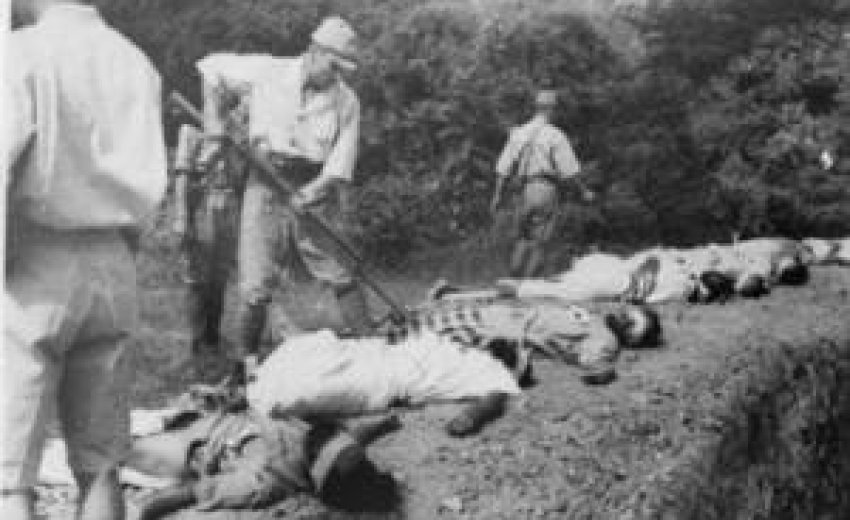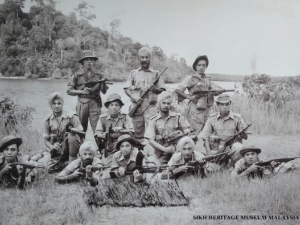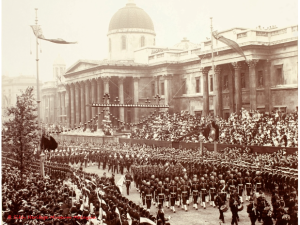"Anyone who closes his eyes to the past is blind to the present. Whoever refuses to remember the inhumanity is prone to risks of new infection"
- Richard Von Weizsacker, German President, speech to the German Parliament. 1985.
Japanese guards offered Sikh Soldiers all kinds of indignities. Sikh soldiers who had been wounded by air raids had sand thrown over their bodies. On one occasion two Sikhs who were found with biscuits in their possession had their 'sacred hair' cut off and had tobacco forced into their mouths.
They took us out and made sport plucking our beards and another was forced to drink large quantities of water. When he had finished the Japanese jumped on his stomach until water poured from his mouth, ears, nose, and eyes.
These are some of the anecdotal accounts reveled by the Sikh prisoners of war. Murder, massacre, death marches, mutilation, vivisection and even cannibalism were all practiced by the Japanese Soldiers. The mass destruction by starvation and forced labour which turned tens of thousands of healthy men into disease ridden-skeleton was deliberate military policy. These are facts that should not be forgotten.
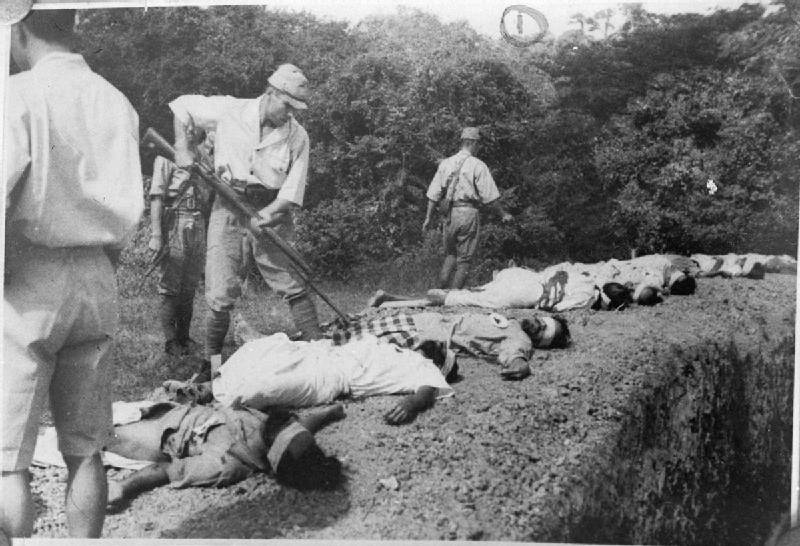
Sikhism had in fact learned early in its infancy that human freedom needed to be jealously guarded. History has recorded many Sikhs who laid down their lives willingly for the principles and beliefs that they hold dear and those dictated by their living Guru, Guru Granth Sahib. The role played by these Sikh soldiers showed that the Sikhs were ready to play the Game of Love as stated by Guru Nanak, and they were sufficiently ready to meet and adversary, whatever the odds. This was made evident in 1699 at Anandpur Sahib, when Guru Gobind Singh asked for the heads of five Sikhs to be sacrificed to his sword. The five Sikhs came literally with "their heads on their palm" to be sacrificed. The oath of the Sikh is as strong as the sword that baptized 'him or her.
This article illustrates how atrocities carried on the Sikhs by the Japanese soldiers in Malaya during World War 2.
Massacre at Parit Sulong.
The 110 wounded Australians and 35 wounded Indians left behind at Parit Sulong were brutally stabbed and incinerated by the Japanese with just one man, badly hurt, surviving to tell the story at war's end.
During World War 2 at the Battle of Muar, members of both the Australian 8th Division and the 45th Indian Infantry Brigade were making a fighting withdrawal when they became surrounded near the bridge of Parit Sulong. The Allies fought the larger Japanese forces for two days until they ran low on ammunition and food. The able-bodied soldiers were ordered to disperse into the jungle, the only way they could return to Allied lines. The wounded were left to fend for themselves.
In the afternoon of January 22nd, 1942, they were ordered to assemble at the rear of a row of damaged shops nearby. The wounded were carried by those able to walk, the pretext being the promise of medical treatment and food. While waiting at the assembly point, either sitting or lying prone, their hands tied with signal wire or rope, three machine guns, concealed in the back rooms of the wrecked shops, started their deadly chatter, their concentrated fire chopping flesh and limbs to pieces. A number of prisoners whose bodies showed signs of life, had to be bayoneted. In order to dispose of the bodies, which totalled 145, the row of shops was blown up and the debris bulldozed into a heap on top of which the corpses were placed. Sixty gallons of gasoline was splashed on the bodies and then a flaming torch was thrown on the pile. Just before midnight, the debris of the nine shops had burned into piles of grey ash two feet high, the 145 bodies totally incinerated.
Anecdotal accounts by local people also reported POWs being tied together with wire and forced to stand on a bridge, before a Japanese soldier shot one, causing the rest to fall into the Simpang Kiri River and drown. 110 Australians and 35 Indians were massacred by the Japanese. Many of the Sikh prisoners were also beheaded. In the face of death, the Sikh prisoners sat with dignity. (If you are zealous of playing the Game of Love, then enter upon my path with your head on your palm. And once you have set your foot on this path, then do not find a way out, but lay down your head.) This call had an electrifying effect on Sikh disciples and left an indelible mark on their psyche.
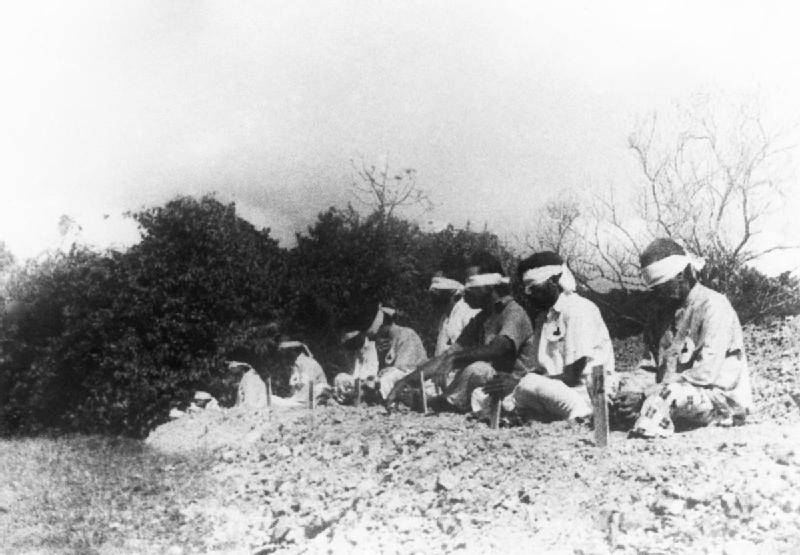
In 2003 an examination of the site was done but no trace of the massacre was found. Later it was found that the drains in the area emptied at low tide making them a perfect mass grave. In the evening high tide the remains would have been washed out to sea. The perpetrator of this foul crime was Lt-Gen. Takuma Nishimura, 62, who gave the following order: "Instruct the officer-in-charge to execute all the prisoners by firing squad. Kill them all. The bodies of the prisoners are to be cremated on completion of the execution and all traces of their disposal obliterated."
Nishimura later faced trial before an Australian Military Court and sentenced to life imprisonment. He was previously convicted of massacres in Singapore and sentenced to life imprisonment by a British Military Tribunal on April 2, 1947. After serving four years of his sentence, he was being transferred to Tokyo to serve out the rest of his sentence and while the ship stopped temporarily at Hong Kong he was seized by the Australian Military Police and taken to Manus Island where his second trial was held. In this trial he was found guilty and hanged on June 11, 1951.
Live target practice at Changi.
Japanese atrocities against Sikhs from the British Indian Army perpetrated at Malaya Singapore are revealed by Lt. Ali Akbar Raja of the 14th Punjab Regiment. This set of four atrocity pictures was found among Japanese records when British troops entered Singapore. The pictures clearly show the inhuman brutality practiced by the Japanese upon their helpless prisoners. Picture shows: - The Sikh prisoners are here seen seated blindfolded with target marks hanging over their hearts and stakes placed in the ground in front of them bearing the butt numbers of each "target". They sit with dignity awaiting their end. These pictures show the Japanese soldiers using Indian prisoners for target practice. Those who survived this ordeal were bayoneted to death
Anecdotal accounts:-
Lt. Ali Akbar Raja ~ 14th Punjab Regiment 1941 ~ 1945(Malaya)One by one they tied our hands behind our backs. There were five of us. We were standing there before a firing squad. When the firing started, I fell. I don't remember anything else. At about three in the morning, I tried to move the big Sikh officer on top of me. His blood was all over me and my uniform. I thought I was dead but I wasn't. I tried to move the others, but they were all dead. At about four or five in the morning, I finally got myself out from under them. Raja was lucky he was alive and escaped into the jungles until the British re-occupation in Singapore in 1945.Raja exposed the ordeal to the investigation officers about the atrocities carried out and the mass graves.
These brave men who played "the game of love" for all free men, couldn't be given their last rites according to the tenets of the Sikh religion, as they were either buried, or drowned in the rivers and marshes of Malaysia or died as prisoners of war in Japanese prison camps, or just disappeared without a trace. They have No known graves. They died that freedom might live .They died to help free the world from violence, hatred and tyranny and surely they have a right to expect that the present, as well as the future, shall be worth their glad Sacrifice.
History tells mass murder comes in many names, of Attila, Genghis Khan, and Tamerlane. Hundreds of Indians and settlers were slaughtered like buffalo. Within the living lifetime: Stalin purged twenty-some millions of his own people. Mao may have topped him during 1949-76. Nazi gave final solution to five or six millions. Kurds have lost millions. The Khmer Rouge killed 1.6 million. Less We Forget! Hope for peace, but be prepared to resist savagery.
Photos Courtesy of Imperial War Museum.
Harchand Singh Bedi Malaysia.
